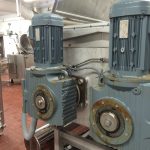When I started in this industry, I worked at my father’s small motor repair shop in a small town north of Toronto. To “Gain The Advantage” over larger motor shops in the city, we provided exceptional customer service, high-quality repairs and recognized early on that plant maintenance practices were very much reactive. As such, we developed a service to provide our clients. In its infancy, our services included on-site surge testing during plant shutdowns and motor management off-site in our warehouse. Fast forward to today and the type of plant maintenance options available are vast, ever-evolving and more user-friendly.
During the EASA convention in Las Vegas last year, a presentation by Jerry Peerbolte and Mark Hoske presented industry research pertaining in part to Plant Maintenance Practices. This section of their presentation showcased several areas in our industry that our members could benefit from including increased opportunities for sales and service.
The presentation is based on a survey of plant, maintenance and reliability engineers and was performed in March of 2019 with 85% of responses from the USA and Canada spanning 44 states and 5 provinces.
As for maintenance strategies for electric motors and rotating equipment, there was a great deal of information presented. One of the highlights I found particularly interesting was that half of the survey respondents ran their motors to fail, making them reactive in their approach to maintenance. The other half of respondents that did employ preventative measures mainly focused on the other rotating equipment downstream of the motor, not the motor itself.
Of course, this could be delved into further by looking at it based on horsepower. If the unit is a 1 HP this unit will likely run until failure and then replaced immediately with a spare from stock. If the motor is 100 HP the proper approach is to monitor and service with proper predictive maintenance programs. This does not mean that the 1HP is not as important in a process as a 100HP, it’s just that the cost to maintain and replace is typically much easier with the lower horsepower.
It was also discussed during the presentation that most respondents used a periodic visual or survey data collection and trending format – approximately 71%. The next largest response indicates that these same users employ a real-time condition monitoring system with pre-established rules or critical alert levels. The end-users in the survey that use real-time condition monitoring or real-time condition monitoring that utilizes machine learning hovered around 20% each. Again, this could be attributed to the importance or size of the motors and/or rotating equipment but does indicate that there is room to grow here. Is this another opportunity for our members to grow their business and realize new income potential?
While respondents recognize the benefits of remote condition-monitoring, whether from OEM’s, third party maintenance service companies or maintenance software service companies, very few use motor shops for this service.
Additionally, almost one-third of these companies state that this type of maintenance practice does not apply to them. While this number seems large, there could be several reasons for this such as lack of budget, smaller operation with smaller horsepower motor-driven equipment, lack of awareness of potential solutions and perhaps something as simple as lack of resources such as IT support internally.
Companies that implemented condition monitoring maintenance practices experienced, in order of largest response to least, uptime improvements, reduced safety risks, lifetime extension of equipment and operating cost reductions. See attached chart for further descriptions and percentages. An interesting result here is that costs or ROI are not one of the top responses.
Finally, it seems while most end users indicate that unscheduled downtime is due to aging equipment roughly the same number plan to decrease unscheduled downtime by upgrading the equipment. This again provides an opportunity for our motor repair members to further increase services and potential sales.
Mechanical failure was the second leading cause of unscheduled downtime according to this survey. This could be due to the age of the equipment, a lack of understanding by the client’s maintenance team or lack of enough maintenance staff during operating hours. Many of us know clients who have reduced their maintenance staff and will typically see an increase in failures as they become reactive in their role and have little to no time for real predictive and preventative maintenance efforts.
As a service provider to our clients, we need to recognize these situations and look to assist when we can. It is our job to educate our clients and ensure they are aware of the latest industry trends, technologies, and services that exist.
To educate ourselves and remain a trusted partner that our clients rely on, we need to stay ahead of the curve and be aware of the systems and technologies that exist in our industry. Fortunately, we have a substantial resource in EASA not only in publications such as this trade magazine but also at the annual tradeshow and networking with fellow members.
Furthermore, our large number of suppliers in this industry offers us a wealth of information on specific plant maintenance practices and pieces that can assist us with completing a customized solution for our customers and help you gain the advantage.
Keep motoring and I am looking forward to seeing you all in Nashville this June.




